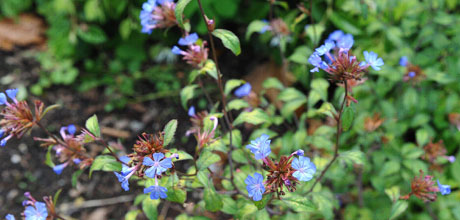From Bright Blooms Straight into Autumn Tones
This article was first published on 23 Apr 2012.

Ceratostigma
Ceratostigma willmottianum spends most of the year in shy modesty. But then, as autumn begins, it starts a pronounced phase of attention seeking behaviour.
While other plants are vying for recognition through spring and summer, C. willmottianum waits quietly with its light green, slightly hairy foliage scattered over a loose collection of wiry stems.
The leaves are almost diamond shaped and the stems are quite rough to the touch and can eventually grow up to a metre tall, but beyond that it is unremarkable.
However, as summer ends, the first flowers appear, beginning a succession of vivid blue gems that extends well into autumn. Following the flowers, the leaves begin to turn colour, deepening to strongly tinted red so that by the time the iridescent blooms are over, the fiery foliage has captured our gaze.
Ceratostigma willmottianum can tolerate a range of soil, from quite poor and dry to moist but well drained. Catering to the wetter end of its tolerance I have it planted at Dunedin Botanic Garden almost directly over a drain at the edge of the Rhododendron Dell’s peat garden. Being low growing, it is best planted close to a path where passers by can appreciate the eye-catching flowers and changing foliage.
As it flowers on new growth and the strongest foliage colour is also produced by new growth, the best autumnal displays come from cutting back old growth in spring. In colder climates though, like Central Otago, severe frosts will do this job for you.
Doug Thomson is curator of the Rhododendron Dell at Dunedin Botanic Garden.


